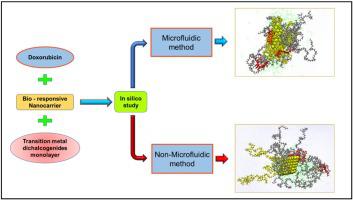Materials Today Communications ( IF 3.7 ) Pub Date : 2020-12-04 , DOI: 10.1016/j.mtcomm.2020.101948 Reza Maleki , Mohammad Khedri , Donya Malekahmadi , Seraj Mohaghegh , Ahmad Miri Jahromi , Mohammad-Ali Shahbazi

|
The rate of Riboflavin (RF) consumption in cancerous cells is interestingly high and this might imply the use of RF ligand in nanocarriers in order to target anticancer drugs into cancer cells. This study aimed to develop a hybrid drug carrier of Doxorubicin (DOX) loaded on RF targeted micelles composed of hydrophobic polylactic-glycolic acid (PLGA) and hydrophilic polyethylene glycol (PEG). In this regard, a simultaneous encapsulation of DOX and in-situ micellization as well as the self-assembly of PLGA-PEG-RF molecules were investigated. Moreover, the effects of microfluidic environment and transition metal dichalcogenide (TMD) nanolayers on the micellization properties (e.g., stability, size, and self-assembly interaction energies) of nanocarriers were simulated for the first time. To this purpose, the simulations were performed using two non-microfluidic methods as well as a novel microfluidic one. The molecular simulations revealed that all of the selected TMDs, especially MoSe2, had a great impact on the stability and size of nanocarriers. MoSe2 significantly enhanced the loading capacity as well as the stability of RF-targeted micelles and reduced the size of nanocarriers. Likewise, the results of various analyses demonstrated that the microfluidic method is the most effective way to synthesize nanocarriers with higher stability and smaller particle size. Hence, the use of MoSe2 monolayer, micelle containing RF, and microfluidic method were believed to be the best approach in order to improve the quality of micelles. The present work sheds new light on the use of TMDs in the synthesis of smart carriers for cancer treatment.
中文翻译:

同时使用阿糖胞苷单层包埋生物靶向的聚合物纳米杂化物同时进行阿霉素包封和原位微流体胶束化:分子硅分子研究
有趣的是,癌细胞中核黄素(RF)的消耗率很高,这可能意味着在纳米载体中使用RF配体可以将抗癌药物靶向到癌细胞中。这项研究旨在开发阿霉素(DOX)的杂种药物载体,该载体装载在由疏水性聚乳酸乙醇酸(PLGA)和亲水性聚乙二醇(PEG)组成的RF靶向胶束上。在这方面,研究了DOX的同时包封和原位胶束化以及PLGA-PEG-RF分子的自组装。此外,首次模拟了微流体环境和过渡金属二硫化二硫(TMD)纳米层对纳米载体的胶束化性质(例如,稳定性,尺寸和自组装相互作用能)的影响。为此,使用两种非微流体方法以及一种新颖的微流体方法进行了仿真。分子模拟表明,所有选定的TMD,特别是MoSe2,对纳米载体的稳定性和尺寸有很大的影响。MoSe 2显着增强了靶向RF的胶束的负载能力以及稳定性,并减小了纳米载体的尺寸。同样,各种分析的结果表明,微流体方法是合成具有较高稳定性和较小粒径的纳米载体的最有效方法。因此,使用MoSe 2单层,包含RF的胶束和微流体方法被认为是改善胶束质量的最佳方法。本工作为TMDs在用于癌症治疗的智能载体的合成中的应用提供了新的思路。











































 京公网安备 11010802027423号
京公网安备 11010802027423号